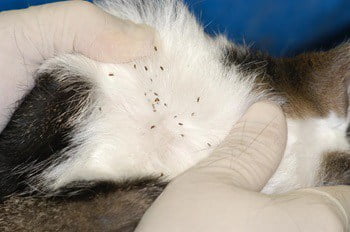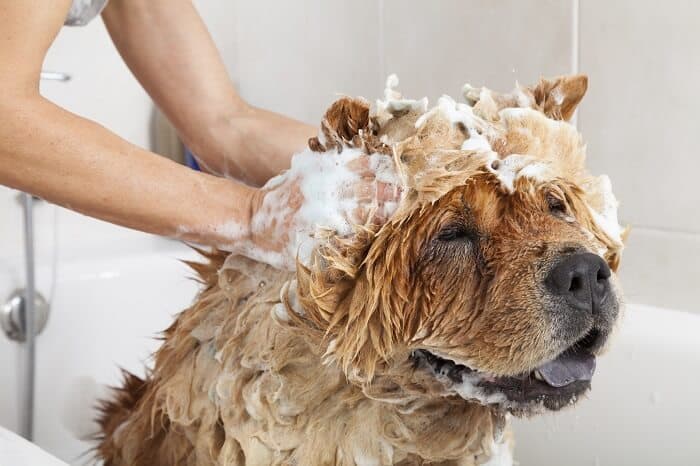Considering flea attacks are an unfortunate but yet fairly common event when it comes to raising a dog there is actually very few articles about the different types of treatment all in one place.
This guide aims to change that by looking at the different ways of combating the pesky intruders and hopefully helping you to choose the best solution in your fight to rid your dog of fleas and ticks.
Depending on the severity of the flea infestation, what you do as a course of elimination is what makes the treatment effective. Because fleas develop in stages it is important you wage a thoroughly extensive eradication war on them while treating your dog.
There are many flea treatment products on the market; however, you must seek to use the product that works best for your dog. Some brands of flea treatment contain certain chemicals which may cause an allergic reaction when used on your pet, so it is important to know what these are. You may want to seek the advice of your veterinarian as to what is best for use.
Flea Treatments for Dogs
The following sections will examine each of the treatments listed below, offering an overview of each type of treatment and how they differ in terms of effectiveness and how they can be applied.
- Flea Shampoos
- Flea Collars
- Flea Dips
- Flea Sprays and Powders
- Flea Drops
- Oral Flea Medications
- Natural Flea Treatments
Flea Shampoos
Flea shampoos as a treatment for an infected dog are the first attack on your war to effectively getting rid of fleas.

The effectiveness of the shampoo is likely to last for a day or two and the best flea shampoo products kill all adult fleas that come into contact with your dog in that time frame.
How it is important to remember that flea shampoos are not a quick fix for your dog’s flea issues. You must also brush and comb your dog after washing them as to remove any dead fleas or ticks from their coat.
Flea Collar
Flea collars are only effective on adult fleas, so won’t help in the battle against eggs and unhatched intruders, this is why a two pronged attack is recommended but more on that later.
After shampooing your dog it is recommended you use a backup treatment for further flea prevention.
A flea collar works by emitting a low residue toxic gas in the area of the neck and shoulders of the dog.
This helps to deter any fleas from attacking for a while. The flea collar is not a complete fix with just one use, and you will need to use it as often as possible along with frequent baths for these products to be most effective.
Flea Dip
Flea dips are most effective when used after shampooing your dog.
You can use a regular dog shampoo if you are planning to use the dip, as the dip contains lots of chemicals.
The dip or rinse is considered an all-around treatment, as it gets rid of ticks, mites as well as fleas.
The lasting effect is one to two weeks, especially if you have shampooed your before and continue to brush and comb your dog thoroughly on a regular basis while the treatment is on going.
Flea Sprays and Powders
Flea sprays and powders are effective in keeping fleas away for a short period of time, but like other products listed here are best when used in conjunction with other products such as a shampoo. This is because they are at their most functional when you keep your dog clean with regular baths.
The spray and powder are powerful on adult fleas and offer additional protection by eliminating the development of flea eggs and larvae. This breaks the flea cycle, a massive step in fighting off fleas completely.
Continuous use of the flea spray and powder is needed as it is only effective during a two to three-day span.
Flea Drops
Flea drops or spot-on-treatments are quite effective in treating fleas and last about a month after application.
It is recommended you consult your veterinarian as to the best one to use on your dog.
The drops are applied between the shoulder blades of the animal, and the chemical components make it effective on inhibiting the development of larvae, as well as preventing the larvae from hatching from their eggs.
Oral Flea Medication
Oral flea medication is effective for rendering the eggs infertile.
Because the flea feeds on blood, the insect upon feeding will lay her eggs but they are not fertile, as the chemicals in the medication make this impossible.
The oral medication though is not effective on adult fleas, but because of the effects on the eggs, it will help to cut down the flea population over time, again breaking the cycle. To kill the adult fleas it is recommended you use one of the other treatments outlined above alongside the medication.
All of the above flea treatments are effective, however, they are made from chemical compounds that may be harmful to your dog in some measure, as mentioned above, they may develop allergic reactions to any.
There are natural flea treatments that are also effective in dealing with flea issues in the home and on your dog which the last section below explores.
Natural Flea Treatments
There are many natural remedies for effectively treating fleas on your dog. They can be far healthier as well as good for the environment.
The eucalyptus plant is a very good deterrent for fleas as they hate the odor. Rubbing your dog with crushed eucalyptus leaves all over or using the eucalyptus oil to groom the dog is also effective.
The odor of the plant is pleasant and is nice for cleaning and deodorizing the air which is an added bonus.
Treating your grounds and the perimeter of your home with borax powder is another good deterrent for flea infestation. The borax powder is a non-toxic compound that prevents fleas from coming near your dog.
Another natural and effective treatment for fleas is an essential oil known as “tick-weed.” This is sprayed around the home on carpets, couches, and drapes that are perfect homes for fleas.
Having covered the many ways to treat and successfully eliminating fleas from your dog, one most important component is a clean home.
If you have a clean and flea free dog and your home is not rid of any larvae or adult insects, you will eventually have another infestation of the dog.
Vacuum the home completely, even the corners. Vacuum the drapes as well as couches because larvae and adult fleas live in these areas.
They feed off dead skin, moisture, as well as food, dropped on the floor or carpets left uncleaned. This direct cleaning must be done daily as it will suck up any larvae, adult fleas, as well as pupae that are laying around just waiting for the time to mature.
It is also advised to put a flea collar in the vacuum, which will kill any fleas sucked up in the vacuum. Proper disposal of the vacuum bag is important as well as changing bags frequently.
Treating the yard is also important; if the dog is allowed to play outdoors they will become reinfected, and you will have to start the cleaning process all over.
Using a non-toxic insecticide for this procedure is recommended or hiring a professional to ensure thorough coverage may be a more effective way to go.
Whatever method you choose to de-flea your dog, you must always examine the fur to ensure they are flea free fquently after your chosen course of treatment.
Remember, not all dogs are free from fleas and if your dog comes in contact with other dogs they may become infected again, so being extra precaution during this period is the way to go.
Author Bio
Jenny Nolan is a professional pet groomer who when she isn’t contributing to family run blog Cleaner Paws with Mom Sue can be found keeping her two King Charles Spaniels as active as possible.
